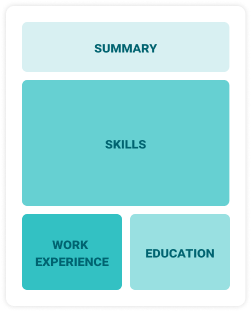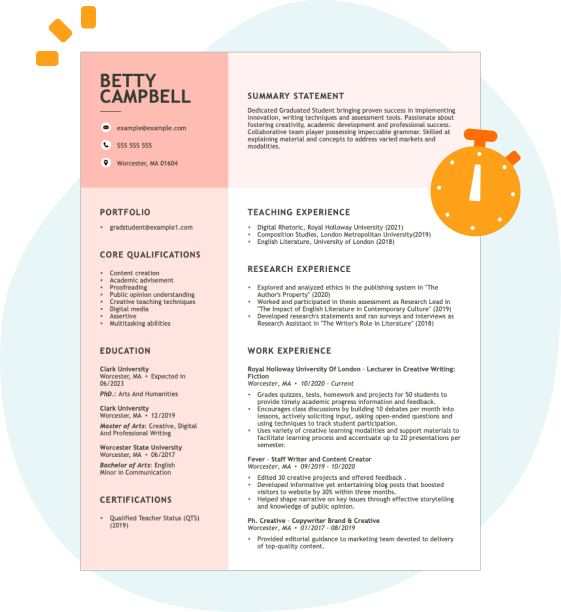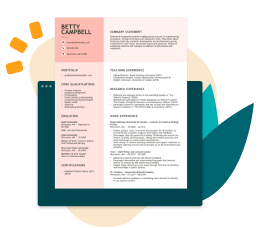Hard skills include technical abilities such as fire suppression techniques, emergency medical response, and equipment operation to ensure effective firefighting and rescue operations.
Popular Firefighter Resume Examples
Check out our top firefighter resume examples that showcase critical skills such as emergency response, teamwork, and leadership. These samples highlight how to effectively present your qualifications to get noticed by hiring managers.
Ready to build your own impressive resume? Resume Builder offers user-friendly templates specifically designed for firefighting professionals, helping you shine in your job search.
Entry-level firefighter resume
This entry-level resume for a firefighter highlights the applicant's extensive emergency response experience and demonstrated leadership skills through various roles in fire and rescue services. New professionals must showcase their relevant training, certifications, and practical skills to effectively communicate their readiness for the demands of a firefighter position, even with limited direct work experience.
Mid-career firefighter resume
This resume effectively showcases key qualifications by detailing extensive emergency response experience and leadership roles. The structured presentation highlights the applicant's readiness for advanced firefighting challenges, demonstrating a commitment to public safety and continuous improvement.
Experienced firefighter resume
This work experience section illustrates the applicant's extensive firefighting experience, demonstrating their leadership and impact on community safety. Key achievements include reducing incident response times by 15% and saving properties worth $2M, with bullet points improving clarity for hiring managers.
Resume Template—Easy to Copy & Paste
Chris Jones
Portland, ME 04105
(555)555-5555
Chris.Jones@example.com
Professional Summary
Dedicated firefighter with four years of expertise in emergency response and fire safety, skilled in rapid operations and public safety training. Proven track record in enhancing operational efficiency and community safety.
Work History
Firefighter
City Rescue Services - Portland, ME
July 2023 - October 2025
- Responded to 100+ emergency calls monthly
- Trained 10 new recruits in safety protocols
- Improved response time by 15% in two years
Emergency Response Specialist
Midwest Emergencies - Portland, ME
July 2021 - June 2023
- Coordinated 50+ rescue operations annually
- Reduced incident misreport by 20%
- Ensured equipment readiness daily for 100% reliability
Fire Safety Officer
SafeGuard Initiatives - Portland, ME
October 2019 - June 2021
- Conducted 200+ fire safety drills
- Increased community outreach by 30%
- Inspected safety compliance for 50+ buildings
Skills
- Emergency Response
- Firefighting Techniques
- Safety Protocols
- Equipment Maintenance
- Community Risk Reduction
- Critical Thinking
- Training and Development
- Incident Command Systems
Education
Master's in Fire Science Fire Science
Chicago State University Chicago, Illinois
June 2019
Bachelor's in Emergency Management Emergency Management
University of Illinois Urbana-Champaign, Illinois
June 2017
Certifications
- Certified Firefighter - National Fire Protection Association
- CPR and First Aid - American Red Cross
Languages
- Spanish - Beginner (A1)
- French - Beginner (A1)
- Italian - Beginner (A1)
How to Write a Firefighter Resume Summary
Your resume summary is the first impression you make on hiring managers, so it’s important to craft it thoughtfully. As a firefighter, you should highlight your skills in emergency response, teamwork, and physical fitness to capture their attention.
In this section, focus on showcasing your ability to handle high-pressure situations and your dedication to public safety. These qualities are essential for anyone looking to excel in this challenging yet rewarding profession.
To illustrate what makes an effective firefighter resume summary, we’ll look at some examples that will clarify what works well and what doesn’t:
Weak resume summary
I am a dedicated firefighter with years of experience in emergency response. I hope to find a position that allows me to use my skills effectively and contribute positively to the community. A job that offers a supportive environment and opportunities for advancement would be perfect for me. I am ready to help your team succeed if given the chance.
- Lacks specific achievements or skills related to firefighting, making it too general
- Emphasizes what the job seeker seeks from employment rather than detailing their contributions
- Contains vague language that doesn't highlight unique qualifications or experiences relevant to firefighting
Strong resume summary
Experienced firefighter with over 7 years in emergency response and fire suppression, successfully managing high-stress situations to ensure community safety. Achieved a 30% reduction in response times by implementing new dispatch protocols and improving team training programs. Proficient in hazardous materials handling, CPR certification, and advanced firefighting techniques.
- Highlights specific years of experience and key responsibilities in emergency response
- Includes quantifiable achievements that showcase the applicant's impact on community safety
- Mentions relevant technical skills that are important for a firefighter role
PRO TIP
Showcasing Your Work Experience
The work experience section is the core of your resume as a firefighter and where you’ll present most of your qualifications. Good resume templates will always emphasize this important part.
This section should be laid out in reverse-chronological order, detailing your previous firefighting roles. Be sure to include bullet points highlighting your specific achievements and contributions in each position.
To illustrate effective entries, we’ll provide a couple of examples that showcase what works well and what to avoid:
Firefighter
City Fire Department – Anytown, USA
- Responded to emergency calls.
- Performed fire suppression tasks.
- Maintained equipment and trucks.
- Participated in training sessions.
- Lacks details on specific incidents or outcomes achieved
- Bullet points are generic and do not highlight unique skills or contributions
- Does not mention any measurable results from actions taken during emergencies
Firefighter
City Fire Department – Los Angeles, CA
March 2020 - Current
- Respond to emergency calls and extinguish fires in residential and commercial buildings, achieving a response time of under 5 minutes during peak hours.
- Conduct safety inspections and educate the community on fire prevention, resulting in a 30% decrease in local fire incidents over one year.
- Lead training sessions for new recruits, improving team performance and ensuring compliance with safety protocols.
- Uses strong action verbs to clearly communicate the applicant’s achievements
- Incorporates specific metrics that highlight the effectiveness of their actions
- Demonstrates relevant skills such as leadership and community engagement essential for firefighting
While your resume summary and work experience are important elements, don't overlook the importance of other sections. Each part plays a role in showcasing your skills. For more detailed guidance, check out our comprehensive guide on how to write a resume.
Top Skills to Include on Your Resume
Including a skills section on your resume is important as it allows you to quickly demonstrate your qualifications. This part of your resume helps hiring managers see that you possess the essential abilities they are looking for in a firefighter.
Strengthen your application by highlighting a combination of hard and soft skills on your resume.
Soft skills, like teamwork, communication, and problem-solving, are important for maintaining safety and fostering collaboration in high-stress situations.
Selecting the right resume skills is important since employers often look for specific competencies that align with their needs. Also, many organizations use automated systems to filter out job seekers who lack these essential skills.
To effectively highlight your qualifications, carefully examine job postings for insights on desirable skills. This approach will not only help you catch the attention of recruiters but also ensure your resume meets the criteria set by ATS technology.
PRO TIP
10 skills that appear on successful firefighter resumes
Improve your resume to grab the attention of recruiters by highlighting essential skills that are highly valued in firefighter positions. You can observe these skills illustrated in our resume examples, giving you the confidence needed to apply for your desired roles.
Here are 10 skills you should consider including in your resume if they align with your qualifications and job requirements:
Fire suppression techniques
Emergency medical response
Teamwork and collaboration
Problem-solving abilities
Physical fitness and endurance
Knowledge of fire safety regulations
Effective communication
Leadership qualities
Hazardous materials handling
Technical skill with firefighting equipment
Based on analysis of 5,000+ fire fighting professional resumes from 2023-2024
Resume Format Examples
Selecting the ideal resume format is important for firefighters to effectively showcase their skills, experience, and dedication to public safety.
Functional
Focuses on skills rather than previous jobs

Best for:
Recent graduates and career changers with limited experience in firefighting
Combination
Balances skills and work history equally

Best for:
Mid-career professionals seeking to demonstrate their skills and potential for growth
Chronological
Emphasizes work history in reverse order

Best for:
Seasoned leaders excelling in emergency response and team management
Firefighter Salaries in the Highest-Paid States
Our firefighter salary data is based on figures from the U.S. Bureau of Labor Statistics (BLS), the authoritative source for employment trends and wage information nationwide.
Whether you're entering the workforce or considering a move to a new city or state, this data can help you gauge what fair compensation looks like for firefighters in your desired area.
Frequently Asked Questions
Should I include a cover letter with my firefighter resume?
Absolutely, including a cover letter is essential for making your application stand out. It allows you to showcase your passion for firefighting and highlight relevant skills that may not be evident in your resume. If you're looking for guidance, check out our tips on how to write a cover letter or use our Cover Letter Generator for a quick start.
Can I use a resume if I’m applying internationally, or do I need a CV?
When applying for jobs abroad, use a CV instead of a resume if the employer requests one. A CV provides a comprehensive overview of your qualifications and experiences. For guidance on how to write a CV, explore our selection of CV examples and helpful writing tips.
What soft skills are important for firefighters?
Soft skills like communication, teamwork, and problem-solving are essential for firefighters. These interpersonal skills foster collaboration during emergencies and help build trust with the community, ensuring effective responses and stronger relationships with colleagues and those they serve.
I’m transitioning from another field. How should I highlight my experience?
Highlight your transferable skills such as teamwork, resilience, and communication gained from previous roles. These abilities illustrate your potential to excel as a firefighter, even if you lack direct experience. Share specific instances that link your past successes to the demands of firefighting duties, showcasing how you can make a meaningful impact in the role.
Should I include a personal mission statement on my firefighter resume?
Yes, including a personal mission statement on your resume is recommended. It effectively conveys your commitment to service and teamwork, aligning with the values important in firefighting. This approach shines particularly when applying to departments that prioritize community engagement and strong team dynamics.
How do I add my resume to LinkedIn?
To boost your resume's visibility on LinkedIn, add your resume to LinkedIn by uploading it directly to your profile or emphasizing key skills and experiences in the "About" and "Experience" sections. This strategy assists recruiters in locating qualified job seekers like you more efficiently, thereby increasing your chances of securing that firefighter position.







